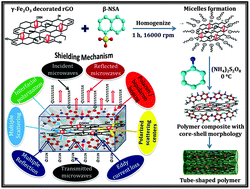Encapsulation of γ-Fe2O3 decorated reduced graphene oxide in polyaniline core–shell tubes as an exceptional tracker for electromagnetic environmental pollution†
Abstract
The ultimate goal of the development of a new material γ-Fe2O3 decorated reduced graphene oxide (rGO)–polyaniline (PANI) core–shell tubes has been done for absorbing electromagnetic interference (EMI) pollution. Herein, we report on the synthesis and characterization of PANI tubes consisting of rGO decorated with iron oxide nanoparticles (RF). The intercalated RF was synthesized by thermal decomposition of ferric acetyl acetonate in a reducing atmosphere. Furthermore, RF was encapsulated through oxidative polymerization of aniline in the presence of β-naphthalene sulphonic acid which results in RF–PANI core–shell morphology. Scanning electron microscopy results confirm the formation of tubular core–shell morphology having 5–15 μm length and 1–5 μm diameter. The presence of rGO–γ-Fe2O3 in PANI core enhances the interfacial polarization and the effective anisotropy energy of the composite which contributes to more scattering and leads to high shielding effectiveness (SET ∼ 51 dB) at a critical thickness of 2.5 mm. Additionally, the effective complex permeability and permittivity parameters of the composites have been evaluated from the experimental scattering parameters (S11 & S21) using theoretical calculations given in Nicholson–Ross and Weir algorithms.


 Please wait while we load your content...
Please wait while we load your content...